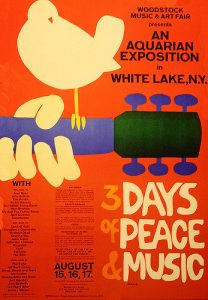“The Woodstock Music & Art Fair” (aka, Woodstock) first debuted as a three day music festival in Bethel, White Lake, New York. The first event in in 1969 attached an audience of 400,000 people.2 Some of the artists that performed in the first Woodstock were: “The Grateful Dead”, “The Incredible String Band”, “Janis Joplin”, “The Who”, “Blood Sweat & Tears”, “Crosby, Stills, Nash & Young” and the headliner: Jimi Hendrix.
To many, Woodstock is remembered as a festival of “Love, Peace and Music”. To others, it was seen as a place for “hippies” and other social outcasts. A cartoon drawn by artist, “Bad Dog” shows the audience of Woodstock on a television screen being criticized by the television viewers. The cartoon serves as a cover for an article written with the intention of criticizing Woodstock. They refer to it as “The Music and Mud Fair”1. The article continues:
“The promoters didn’t try hard enough from the start. They planned enough for greasy-spoon food for 200,000 but the population exploded into into twice that many; there were very few doctors (later they flew them in, like in Vietnam)…” -LNS1
This quote equates flying in medical professionals to Woodstock to war-torn Vietnam, flying in supplies and medical help.The article continues to slam the promoters of the music festival saying that they were subjecting the audience to the elements thus forcing them to by tents when the article says the promotes could have “put up a few large circus tents just in case of rain”… the article continues to not only bash the promoters, but also the attendees:
“Each time the rain died down, the wet and bedraggled built fires out of trash, anything half-dry they could find in the nearby woods, and even lumber limber liberated from concession stands, but so many were tripping or tired that the fires warmed only those heads were clearly focused on survival.” -LNS1
This ad hominem attack seems like a low blow from the author. I think that this tone comes from a writer who is fearful about the direction the music and the new generation is heading.
It is new.
It is different.
It is “other”
Work Cited:
1 “Planned Disaster LNS snarls” And I danced in the mud, the blood, and the beer. Ann Arbor Argus, Woodstock, n.d. © The Rock and Roll Hall of Fame and Museum. link
2 ‘Woodstock,’ A fete of love peace and music relived in film set for the state-lake. (1970, Apr 22). Chicago Daily Defender (Daily Edition) (1960-1973) Retrieved from link
Skolnick, Arnold, Artist. An aquarian exposition in White Lake, N.Y.–3 days of peace & music / Skolnick. Bethel New York, 1969. [New York: Woodstock Music and Art Fair] Photograph. Retrieved from the Library of Congress, link (Accessed October 17, 2017.)


